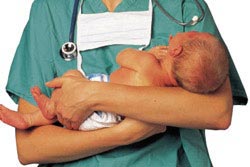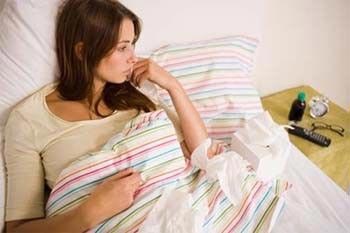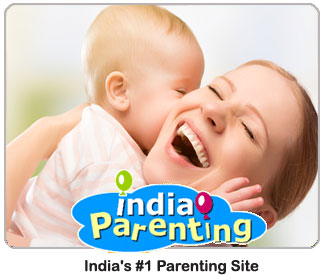Sometimes post delivery bleeding may turn into a haemorrhage. There are various causes behind post delivery haemorrhage. Read on to know more about post delivery haemorrhage. In this articleWhat Exactly is The Condition?The Clinical Condition of Post Delivery HaemorrhageTypes of Post Delivery HaemorrhagesWhat Exactly is The Condition? In simple term post delivery haemorrhage refers to the condition where there is a blood loss of 500ml or beyond. An important point needs to be noted here, this 500ml range defines post delivery haemorrhage when the baby is born through a vaginal delivery. If there is a caesarean delivery, post delivery haemorrhage is said to happen when the blood loss is 1000ml or more than that. In cases where the mother is a healthy young woman, a fair amount of blood loss can be tolerated by her system; the situation complicates with the advancement of age and several other associated factors. The more uncomplicated the delivery is, the better it is for the woman to override it without compromising the safety of her health. The Clinical Condition of Post Delivery Haemorrhage Given below are brief discussions of the various symptoms that define post delivery haemorrhage: The__10%_Drop_in_Haemoglobin">The 10% Drop in Haemoglobin During childbirth, a drop of around 10% in haemoglobin levels is manageable. Anything that is beyond that refers to post delivery haemorrhage which require clinical expertise. As the situation becomes more and more acute, it simultaneously goes beyond control. This is because; the changes in the red blood cells require hours to become effective. This thereby entails that in order to induce any positive change in the condition the woman is simply not in a position to afford this amount of time. Hypovolemia This is a potent symptom of post delivery haemorrhage. The associated noticeable clinical symptoms are light headedness, fatigue, syncope, tachycardia and oliguria. The problem here is, they all are of limited utility. Even in a young and otherwise healthy woman, the array of two or more of these symptoms can be a late finding. This complicates the condition furthermore. Thereby as the uncontrollable bleeding commences, it always has the potential to cause haemodynamic instability. If the condition is not controlled by the physician, it might result in severe post delivery haemorrhage. Types of Post Delivery Haemorrhages Post delivery haemorrhage can be classified as early post delivery haemorrhage and late post delivery haemorrhage. Early Post Delivery Haemorrhage This occurs within 24 hours of childbirth. In more than 99% of the cases, this is the type of haemorrhage that occurs. Although this is an unwanted situation, this haemorrhage is easier to control as the woman is still under the care of the heath care provider. Thereby she can be kept under constant monitoring and is attended immediately. Late Post Delivery Haemorrhage This occurs within 24 hours to 6 weeks post childbirth. This can be a dangerous condition if the woman is living far from the nearest and appropriate clinical facilities. Here the cases are divided into the following categories –If the woman who is close to her delivery time is being transferred to a separate location either in need of a better facility, a delivery suite or the existing facility’s labour unit. The point is, every minute is crucial.If the childbirth takes place at a non-hospital facility, the woman can be haemodynamically unstable to sustain the shift. Even transferring her from the delivery suite in one floor to another unit might be strenuous.If the woman is discharged after childbirth in a stable condition but a sudden bleeding erupts and the visit of the emergency personnel is delayed. It is not really easy to define post delivery haemorrhage. This fact becomes clear if you go through medical history and researches. And this the very reason why the post delivery haemorrhages criteria becomes so difficult to deal with in certain cases. This means the research poor settings define the complexity and difficulty, especially when the haemorrhage is unexpected and sudden.
Sometimes post delivery bleeding may turn into a haemorrhage. There are various causes behind post delivery haemorrhage. Read on to know more about post delivery haemorrhage. What Exactly is The Condition?
In simple term post delivery haemorrhage refers to the condition where there is a blood loss of 500ml or beyond. An important point needs to be noted here, this 500ml range defines post delivery haemorrhage when the baby is born through a vaginal delivery. If there is a caesarean delivery, post delivery haemorrhage is said to happen when the blood loss is 1000ml or more than that.
In cases where the mother is a healthy young woman, a fair amount of blood loss can be tolerated by her system; the situation complicates with the advancement of age and several other associated factors. The more uncomplicated the delivery is, the better it is for the woman to override it without compromising the safety of her health.
The Clinical Condition of Post Delivery Haemorrhage Given below are brief discussions of the various symptoms that define post delivery haemorrhage:
The__10%_Drop_in_Haemoglobin">The 10% Drop in Haemoglobin During childbirth, a drop of around 10% in haemoglobin levels is manageable. Anything that is beyond that refers to post delivery haemorrhage which require clinical expertise. As the situation becomes more and more acute, it simultaneously goes beyond control. This is because; the changes in the red blood cells require hours to become effective. This thereby entails that in order to induce any positive change in the condition the woman is simply not in a position to afford this amount of time.
Hypovolemia This is a potent symptom of post delivery haemorrhage. The associated noticeable clinical symptoms are light headedness, fatigue, syncope, tachycardia and oliguria. The problem here is, they all are of limited utility. Even in a young and otherwise healthy woman, the array of two or more of these symptoms can be a late finding. This complicates the condition furthermore. Thereby as the uncontrollable bleeding commences, it always has the potential to cause haemodynamic instability. If the condition is not controlled by the physician, it might result in severe post delivery haemorrhage.
Types of Post Delivery Haemorrhages
Post delivery haemorrhage can be classified as early post delivery haemorrhage and late post delivery haemorrhage.
Early Post Delivery Haemorrhage This occurs within 24 hours of childbirth. In more than 99% of the cases, this is the type of haemorrhage that occurs. Although this is an unwanted situation, this haemorrhage is easier to control as the woman is still under the care of the heath care provider. Thereby she can be kept under constant monitoring and is attended immediately.
Late Post Delivery Haemorrhage This occurs within 24 hours to 6 weeks post childbirth. This can be a dangerous condition if the woman is living far from the nearest and appropriate clinical facilities. Here the cases are divided into the following categories –
- If the woman who is close to her delivery time is being transferred to a separate location either in need of a better facility, a delivery suite or the existing facility’s labour unit. The point is, every minute is crucial.
- If the childbirth takes place at a non-hospital facility, the woman can be haemodynamically unstable to sustain the shift. Even transferring her from the delivery suite in one floor to another unit might be strenuous.
- If the woman is discharged after childbirth in a stable condition but a sudden bleeding erupts and the visit of the emergency personnel is delayed.
It is not really easy to define post delivery haemorrhage. This fact becomes clear if you go through medical history and researches. And this the very reason why the post delivery haemorrhages criteria becomes so difficult to deal with in certain cases. This means the research poor settings define the complexity and difficulty, especially when the haemorrhage is unexpected and sudden.




























